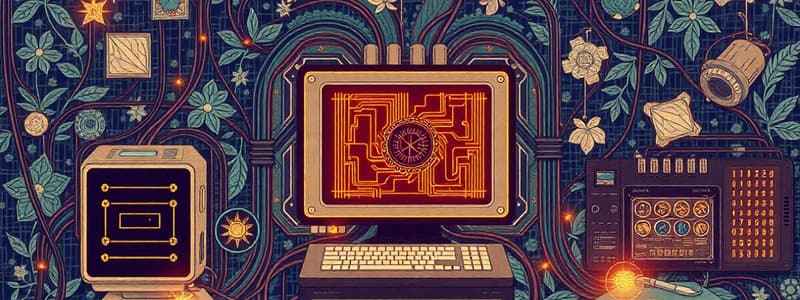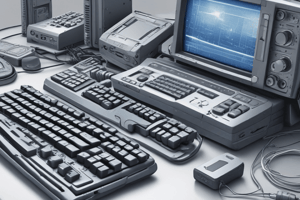Podcast
Questions and Answers
Which of the following components is responsible for performing calculations and logic in a computer system?
Which of the following components is responsible for performing calculations and logic in a computer system?
- Control Unit (CU)
- Storage Devices
- Arithmetic and Logic Unit (ALU) (correct)
- Primary Memory
Secondary memory is volatile and loses its content when the power is turned off.
Secondary memory is volatile and loses its content when the power is turned off.
False (B)
Name the two main categories that a computer system is divided into.
Name the two main categories that a computer system is divided into.
hardware and software
The __________ directly manages system resources like RAM and peripherals.
The __________ directly manages system resources like RAM and peripherals.
Match the memory types with their characteristics:
Match the memory types with their characteristics:
What is the main purpose of output devices in a computer system?
What is the main purpose of output devices in a computer system?
The __________ cycle consists of fetching, decoding, executing, and saving instructions.
The __________ cycle consists of fetching, decoding, executing, and saving instructions.
Touch screens can only function as output devices.
Touch screens can only function as output devices.
Flashcards
Computer System
Computer System
A computer system integrates devices to input, output, process, and store data. It's divided into two key parts: hardware (physical components) and software (instructions and programs).
Input Devices
Input Devices
Input devices allow information to be entered into the computer system. Manual input devices require human interaction (like a keyboard). Direct Input devices rely on sensors or other methods with less human involvement (like barcode scanners).
Output Devices
Output Devices
Output devices translate information processed by the computer into forms that humans can understand, like audio, visual displays, or printed documents. Touchscreens can act as both input and output.
Processor (CPU)
Processor (CPU)
Signup and view all the flashcards
Memory and Storage
Memory and Storage
Signup and view all the flashcards
System Software
System Software
Signup and view all the flashcards
Application Software
Application Software
Signup and view all the flashcards
Fetch-Execute Cycle
Fetch-Execute Cycle
Signup and view all the flashcards
Study Notes
Computer System Overview
- Computer systems combine hardware and software to process data.
- Hardware comprises physical components, while software provides instructions.
Hardware Components
Input Devices
- Manual Input: Involve human interaction (e.g., keyboard, light pen).
- Direct Input: Minimal human intervention (e.g., sensors, magnetic stripe readers).
Output Devices
- Transform computer data to user-readable formats (audio, visual, print).
- Touch screens act as both input and output devices.
Processor (CPU)
- The CPU executes instructions.
- Composed of:
- Control Unit (CU): Manages operations.
- Arithmetic Logic Unit (ALU): Performs calculations and logic.
- Clock: Synchronizes actions with timing pulses.
Memory and Storage
- Primary Memory: Fast, volatile memory (RAM, ROM).
- Secondary Memory: Non-volatile, long-term storage (HDD, SSD).
- RAM: Temporary, fast memory; ROM: Permanent, stores essential programs.
Software Types
System Software
- Manages computer resources (RAM, peripherals).
Application Software
- Programs designed for specific tasks (word processing, etc.)
Fetch-Execute Cycle
- Includes four stages: Fetch, Decode, Execute, Save.
- This cycle is repeated millions of times each second.
- The CPU fetches instructions, decodes them, executes their logic and stores results.
Studying That Suits You
Use AI to generate personalized quizzes and flashcards to suit your learning preferences.




